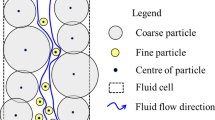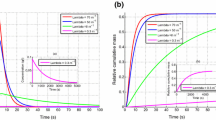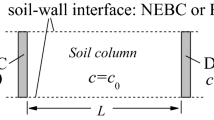Abstract
To study the internal phenomenon of suffusion process in granular soils and determine its influence of the seepage direction, numerical simulations were conducted using the Particle Flow Code (PFC) software in different seepage directions. The fixed coarse-grid fluid scheme in PFC3D was used for particle-fluid coupling simulations, and a new gravity-applied method was implemented to simulate different seepage directions. Variations in the mean contact force, flow rate, porosity, permeability, and number and volume of escaped particles with an increasing hydraulic gradient and the migration pathways of fine particles during the simulation were monitored and analyzed. The results show that a larger seepage angle corresponds to a smaller flow rate under the same hydraulic gradient. The fine particles initially moved downward under gravity and then stopped and remained at a certain position. The fine particles subsequently began to move upward and finally escaped from the top surface of the model. The migration pathways of fine particles were random and their directions of motion changed continuously.








Similar content being viewed by others
References
Asgian MI, Cundall PA, Brady BHG (1995) The mechanical stability of propped hydraulic fractures: a numerical study. In Proceedings of the SPE 69th Annual Technical Conference and Exhibition, New Orleans, America, vol. 1, pp 475-489
Bear J (1979) Hydraulics of Groundwater. McGraw-Hill Book Company, New York
Bendahmane F, Marot D, Alexis A (2008) Experimental parametric study of suffusion and backward erosion. J Geotech Geoenviron 134(1):57–67
Bouillard JX, Lyczkowski RW, Gidaspow D (1989) Porosity distributions in a fluidized bed with an immersed obstacle. Aiche J 35(6):908–922
Chang DS, Zhang LM (2011) A stress-controlled erosion apparatus for studying internal erosion in soils. Geotech Test J 34(6):579–589
Chang DS, Zhang LM (2013) Critical hydraulic gradients of internal erosion under complex stress states. J Geotech Geoenviron 139(9):1454–1467
Chapuis RP (1992) Similarity of internal stability criteria for granular soils. Can Geotech J 29(4):711–713
Ergun S (1952) Fluid flow through packed columns. Chem Eng Prog 48(2):89–94
Fleshman MS, Rice JD (2013) Constant gradient piping test apparatus for evaluation of critical hydraulic conditions for the initiation of piping. Geotech Test J 36(6):834–846
Hekmatzadeh AA, Zarei F, Johari A, Haghighi AT (2018) Reliability analysis of stability against piping and sliding in diversion dams, considering four cutoff wall configurations. Comput Geotech 98:217–231
Itasca (2005) PFC3D-Particle Flow code in 3Dimensions, Version 3.1. Itasca Consulting Group, Inc, Minneapolis
Johari A, Heydari A (2018) Reliability analysis of seepage using an applicable procedure based on stochastic scaled boundary finite element method. Eng Anal Bound Elem 94:44–59
Kenney TC, Lau D (1985) Internal stability of granular filters. Can Geotech J 22(2):215–225
Moffat RA, Fannin RJ (2006) A large permeameter for study of internal stability in cohesionless soils. Geotech Test J 29(4):273–279
Moffat R, Fannin RJ (2011) A hydromechanical relation governing internal stability of cohesionless soil. Can Geotech J 48(3):413–424
Moffat R, Fannin RJ, Garner SJ (2011) Spatial and temporal progression of internal erosion in cohesionless soil. Can Geotech J 48(3):399–412
Moraci N, Mandaglio MC, Ielo D (2012) A new theoretical method to evaluate the internal stability of granular soils. Can Geotech J 49(1):45–58
Richards KS, Reddy KR (2007) Critical appraisal of piping phenomena in earth dams. B Eng Geol Environ 66(4):381–402
Richards KS, Reddy KR (2010) True triaxial piping test apparatus for evaluation of piping potential in earth structures. Geotech Test J 33(1):83–95
Richards KS, Reddy KR (2012) Experimental investigation of initiation of backward erosion piping in soils. Geotechnique 62(10):933–942
Shimizu Y (2004) Fluid coupling in PFC2D and PFC3D. In numerical modeling in micromechanics via particle methods. In Proceedings of the 2nd International PFC Symposium, Kyoto, Japan, pp 281-287.
Skempton AW, Brogan JM (1994) Experiments on piping in sandy gravels. Geotechnique 44(3):449–460
Tomlinson SS, Vaid YP (2000) Seepage forces and confining pressure effects on piping erosion. Can Geotech J 37(1):1–13
Wan CF, Fell R (2008) Assessing the potential of internal instability and suffusion in embankment dams and their foundations. J Geotech Geoenviron 134(3):401–407
Wen CY, Yu YH (1966) Mechanics of fluidization. Chemical Engineering Progress Symposium Series 162:100–111
Zhou ZQ, Ranjith PG, Li SC (2016) Optimal models for particle size distributions of granular soils. P I Civil Eng-Geotec 169(1):73–82
Zhou ZQ, Ranjith PG, Li SC (2017) Criteria for assessment of internal stability of granular soil. P I Civil Eng-Geotec 170(1):73–83
Zhou ZQ, Ranjith PG, Li SC (2018) An experimental testing apparatus for study of suffusion of granular soils in geological structures. Tunn Undergr Sp Tech 78:222–230
Zhou ZQ, Ranjith PG, Yang WM, Shi SS, Wei CC, Li ZH (2019) A new set of scaling relationships for DEM-CFD simulations of fluid–solid coupling problems in saturated and cohesiveless granular soils. Comput Part Mech 6(4):657–669
Funding
This study is funded by the National Natural Science Foundation of China (51709159, 51911530214), Shandong Provincial Key R&D Program of China (2019GSF111030); the State Key Laboratory of Mining Disaster Prevention and Control Co-founded by Shandong Province and the Ministry of Science and Technology (MDPC201802); and the CRSRI Open Research Program (Program SN: CKWV2018468/KY).
Author information
Authors and Affiliations
Corresponding authors
Additional information
Responsible Editor: Zeynal Abiddin Erguler
Rights and permissions
About this article
Cite this article
Zhou, Z., Li, Z., Ranjith, P.G. et al. Numerical simulation of the influence of seepage direction on suffusion in granular soils. Arab J Geosci 13, 669 (2020). https://doi.org/10.1007/s12517-020-05504-6
Received:
Accepted:
Published:
DOI: https://doi.org/10.1007/s12517-020-05504-6




